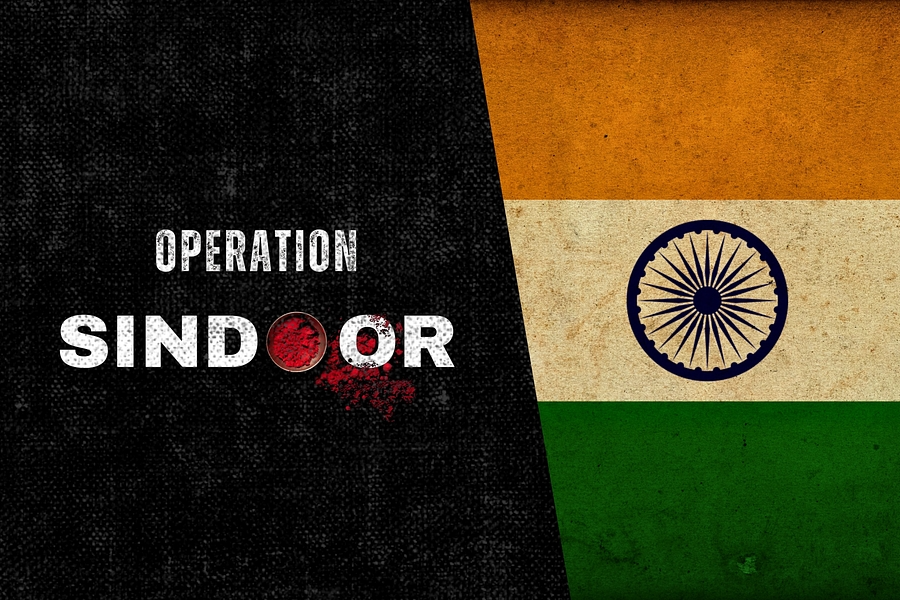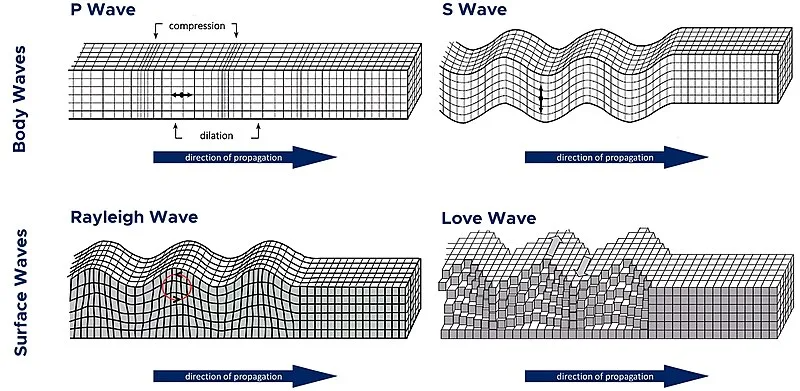October 07th Current Affairs
Table of Contents
Non-Positivist Methodologies in Social Research
Home / Non-Positivist Methodologies in Social Research Shift from Positivism to Non-Positivism As sociologists recognized that social realities cannot be
UPSC Current Affairs – December 3
December 03rd Current Affairs Home / Table of Contents Govt ready to talk about electoral reforms in Parliament, but not
Fact, Value and Objectivity
Home / Fact, Value and Objectivity What is a Fact? A fact is an empirically verifiable observation—something that can be
UPSC Current Affairs – December 2
December 02nd Current Affairs Home / Table of Contents Bioterrorism a serious threat, world not ready: S. Jaishankar Relevance to
Positivism and its Critique
Home / Positivism and its Critique What is Positivism? Positivism is the idea that human behaviour can be studied using
UPSC Current Affairs – December 1st
December 01st Current Affairs Home / Table of Contents Sri Lanka declares state of emergency after floods and mudslides Relevance
Major Theoretical Strands of Research Methodology
Home / Major Theoretical Strands of Research Methodology Research methodology is a broad term that encompasses the entire research process
UPSC Current Affairs – November 25
November 25th Current Affairs Home / Table of Contents Woman from Arunachal Pradesh stopped at China airport; India issues strong
UPSC Current Affairs – November 24
November 24th Current Affairs Home / Table of Contents Justice Surya Kant sworn in as 53rd Chief Justice of India
UPSC Current Affairs – November 21
November 21st Current Affairs Home / Table of Contents What is Cloudflare, and why did half the internet go down
Citing ‘sanatan dharma’, lawyer hurls shoe at CJI Gavai; angered every Indian: PM
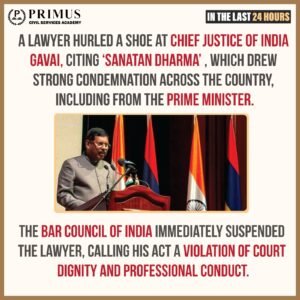
Relevance to UPSC
GS Paper II: Polity,Governance and Constitutional Issues
- Court decorum, dignity, and integrity of institutions
- Responsiveness of institutions to challenges and safeguarding the judiciary
GS Paper IV: Ethics,Integrity and Aptitude
- Professionalism, ethical behavior in public life, conduct of advocates and officers of court
- Respect for institutions and moral responsibility
More About the News
- During Supreme Court proceedings, a 71-year-old advocate allegedly hurled a shoe at Chief Justice of India B. R. Gavai.
- The advocate claimed he was protesting “insult to Sanatan Dharma,” referencing CJI’s remarks in a separate case on a Vishnu idol in Khajuraho.
- The CJI directed no action to be taken against him immediately, and the Bar Council of India suspended the lawyer from practice for misconduct.
Bar Council of India
The Bar Council of India, created by Parliament, is a statutory authority responsible for regulating and representing the legal profession in India. It sets standards for legal education, recognises universities whose law degrees are eligible for enrollment as advocates, and monitors professional conduct. The Council also has the power to exercise disciplinary action against advocates for misconduct.
Establishment & Background
- Statutory, autonomous body established under the Advocates Act, 1961.
- Recommended by All India Bar Committee (1951) and Law Commission (1958) for All India and State Bar Councils.
- Nodal Ministry: Ministry of Law and Justice (Department of Legal Affairs).
Composition of BCI
- Members elected by each State Bar Council (SBC) plus ex-officio members (Attorney-General & Solicitor-General of India).
- Chairman & Vice-Chairman elected by the Council for a 2-year tenure.
- Members from SBCs serve for 5 years or for the term they hold office in their SBC.
Committees of BCI
- Disciplinary Committee, Legal Aid Committee, Executive Committee, Legal Education Committee, and others as needed.
Functions of BCI
- Lay standards of professional conduct for advocates.
- Oversee disciplinary procedures for misconduct.
- Safeguard rights, privileges, and interests of advocates.
- Promote and support law reform and legal education.
- Recognize universities whose law degrees qualify for enrollment.
- Conduct seminars, talks, and organize legal aid for the poor.
- Manage and invest BCI funds and receive grants/donations.
- Recognize foreign legal qualifications on a reciprocal basis.
Funds & Grants of BCI
- For welfare schemes, legal aid, establishing law libraries, and other purposes.
- Can join international legal bodies like the International Bar Association.
Significance of International Affiliations
- Facilitate cross-border legal cooperation amid global trade and transactions.
- Support democracy, rule of law, and better access to justice in bilateral relations.
- Provide legal guidance, advice, and common code of conduct between bars of different countries.
State Bar Councils (SBCs)
- Established under Advocates Act, 1961; currently 24 SBCs exist.
- Composed of elected members (number varies with electorate size) + ex-officio members (Advocate-General).
- Chairman & Vice-Chairman elected from members; tenure 5 years.
- Committees: Disciplinary, Legal Aid, Executive, Enrolment, etc.
Functions of SBCs
- Maintain the role of advocates and admit persons as advocates.
- Ensure professional conduct and safeguard advocate rights.
- Promote bar associations and law firms, conduct seminars, and organize legal aid.
- Manage and invest funds, and inspect universities under BCI guidance.
Funds & Grants of SBCs
- For welfare schemes, legal aid, law libraries.
- Can receive grants, donations, gifts, etc.
Classification of Advocates
- Senior Advocates and Other Practitioners.
- Senior Advocate designation granted by SC/HC for exceptional ability, standing, or special knowledge/experience.
Advocates in the Supreme Court
- Senior Advocates: Cannot appear without Advocate-on-Record (AoR).
- Advocate-on-Record: Exclusive right to file cases; eligibility requires 7 years practice + 1-year training under AoR.
- AoR examination conducted by SC under the Supreme Court Rules, 2013.
- Other advocates: Can appear in SC only under the instruction of AoR or court permission.
Way Forward
- Strengthen Legal Education: Regularly update curriculum and teaching methods to match global standards and emerging areas of law (e.g., cyber law, AI law, environmental law).
- Enhance Professional Ethics: Conduct periodic workshops and training for advocates on ethics, professional conduct, and client-centric practices.
- Improve Disciplinary Mechanisms: Streamline procedures for faster and transparent resolution of complaints against advocates.
- Promote Access to Justice: Expand legal aid programs for marginalized and economically weaker sections across all states.
- Foster Research & Innovation: Support legal research, law journals, and moot court competitions to encourage critical thinking and innovation.
The Bar Council of India acts as a key regulatory and representative body for advocates nationwide. By managing enrollment, overseeing discipline, and promoting legal education, it safeguards the professionalism and integrity of the legal profession. Its international affiliations and collaborations further strengthen its role in advancing legal standards and upholding the rule of law.
Prelims MCQ
With reference to India, consider the following Statements: 1. Government Law Officers and Legal firms are recognized as Advocates, but Corporate Lawyers and Patent Attorneys are excluded from recognition as Advocates. 2. Bar Councils have the power to lay down the rules relating to Legal Education and recognition of Law Colleges. Which of the following statements is/are correct?
A. 1 Only
B. 2 Only
C. Both 1 and 2
D. Neither 1 nor 2 above
Mains Question
Q. Examine the role of the Bar Council of India in regulating the legal profession and promoting legal education. In light of contemporary challenges, critically evaluate whether the BCI is adequately equipped to ensure professional integrity, access to justice, and global standards in legal practice.
India, Australia to sign joint defence and security cooperation declaration
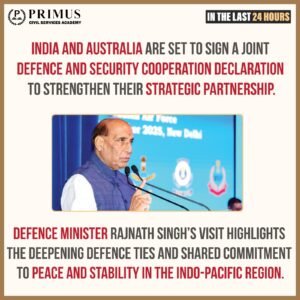
Relevance to UPSC
GS Paper II: International Relations & Foreign Policy
- Strengthening bilateral strategic partnerships and their role in regional stability
- Security cooperation in the maritime domain, joint exercises and information exchange
- Dynamics of power balance in the Indo-Pacific (China’s assertiveness, maritime domain awareness)
- Role of defence diplomacy in national security strategy
GS Paper III: Defence
- Maritime security, coastal security, naval cooperation
- Technology, capabilities and coordination in maritime domain awareness
More About the News
- India and Australia are set to sign/renew defence & security agreements during Defence Minister Rajnath Singh’s upcoming visit, with a strong focus on maritime security and information sharing.
- The agreements include exchange of classified military information, submarine rescue cooperation, and a joint maritime security collaboration roadmap.
- These moves reflect a strategic deepening of bilateral defence ties in response to evolving Indo-Pacific challenges, especially with respect to China’s influence.
India-Australia Ties
India and Australia share a robust and multi-dimensional partnership, spanning trade, defence, education, and climate cooperation. Both countries collaborate closely within frameworks like Quad and bilateral strategic dialogues, emphasizing a free, open, and inclusive Indo-Pacific. Their relations are increasingly shaped by shared democratic values, economic complementarities, and regional security concerns.
Dimension | Details / Pointers |
Evolution of Ties |
|
Important Trends & Data Sets |
|
Major Issues |
|
Trade Ties |
|
Defence Deals / Agreements |
|
Recent Developments |
|
Recent Sparks / Tensions |
|
Strengths in Ties |
|
Weaknesses in Ties |
|
Challenges Faced |
|
Potential of Ties |
|
Common Groupings & Initiatives |
|
Way Forward |
|
The India-Australia partnership is poised to deepen further through enhanced defence cooperation, technological collaboration, and green energy initiatives. Strengthening people-to-people ties and educational exchanges will bolster long-term strategic trust. Continued engagement will position both nations as key pillars of stability and prosperity in the Indo-Pacific region.
Prelims MCQ
Q. Which of the following statements regarding India-Australia relations is/are correct? 1. India and Australia are members of the Quad framework. 2. Both countries have a Free Trade Agreement that has already been fully implemented. 3. Defence and maritime security cooperation form a key pillar of bilateral ties.
A. 1 and 2 only
B. 1 and 3 only
C. 2 and 3 only
D. 1, 2, and 3
Mains Question
Q. Critically examine the strategic, economic, and technological dimensions of India-Australia relations. In the context of an evolving Indo-Pacific, discuss the opportunities and challenges for both nations in enhancing their bilateral partnership.
Medicine Nobel 2025 for scientists who demystified immune system

Relevance to UPSC
GS Paper III: Science & Technology, Health & Biotechnology
- Advances in immunology and their implications for human health
- Role of biomedical research in disease prevention, therapy, and health systems
- Translational science: from lab discovery to clinical trials
More About the News
- The 2025 Nobel Prize in Physiology or Medicine was awarded to Mary Brunkow, Fred Ramsdell, and Shimon Sakaguchi for their groundbreaking work on peripheral immune tolerance i.e. how the immune system regulates itself so it doesn’t attack the body’s own tissues.
- Their discoveries centred on regulatory T cells (Tregs) and the role of the FOXP3 gene in developing these cells, which act as “security guards” of the immune system.
- These findings have major implications for autoimmune disease therapies, transplantation science, and immunotherapy, and many clinical trials are already underway.
Nobel Prize
The Nobel Prize, established by the will of Alfred Nobel in 1895, is one of the most prestigious global awards recognizing outstanding contributions in science, literature, and peace. It symbolizes the pursuit of knowledge, innovation, and human progress. Over the decades, it has become a benchmark for excellence and a source of inspiration worldwide.
History of the Nobel Prize
- Established in 1895 by Swedish industrialist Alfred Nobel, inventor of dynamite.
- First prize awarded in 1901.
- Created to reward those “who, during the preceding year, have conferred the greatest benefit to humankind.”
Categories of the Nobel Prize
- Physics
- Chemistry
- Physiology or Medicine
- Literature
- Peace
- Economic Sciences (added in 1968 in memory of Alfred Nobel)
How Nobel Laureates Are Chosen
- Nominations are invited from experts, professors, previous laureates, and institutions.
- Committees in respective fields evaluate contributions for originality, impact, and benefit to humanity.
- Decisions finalized by the Swedish Royal Academies (except the Peace Prize by the Norwegian Nobel Committee).
Significance of the Nobel Prize
- Recognizes and honors groundbreaking contributions to humanity.
- Inspires global research, innovation, and peace efforts.
- Enhances international visibility and credibility of laureates and their institutions.
Benefits of Receiving the Award
- Monetary reward and medal/certificate.
- Global recognition and prestige.
- Opportunities for further research, collaboration, and influence.
Prominent Indians Who Have Won the Nobel Prize
- Rabindranath Tagore (1913) – Literature
- C.V. Raman (1930) – Physics
- Mother Teresa (1979) – Peace
- Subrahmanyan Chandrasekhar (1983) – Physics
- Amartya Sen (1998) – Economics
- Kailash Satyarthi (2014) – Peace
The Nobel Prize will continue to motivate innovation, ethical research, and global cooperation. Emerging fields like climate science, AI, and biotechnology are likely to shape future laureates. Strengthening international collaboration will ensure the award remains a catalyst for human progress and societal benefit.
Prelims MCQ
Q. Which of the following statements regarding the Nobel Prize is/are correct?
1. The Nobel Peace Prize is awarded by a committee appointed by the Norwegian Nobel Institute.
2. The Prize in Economic Sciences was part of Alfred Nobel’s original will.
3. Nominees for the Nobel Prize can include previous laureates and recognized professors.
A. 1 and 2 only
B. 1 and 3 only
C. 2 and 3 only
D. 1, 2, and 3
Statement 1 is correct: Peace Prize is awarded by the Norwegian Nobel Committee. Statement 2 is incorrect: The Economics prize was established in 1968, not part of Nobel’s original will. Statement 3 is correct: Previous laureates and professors are eligible to nominate candidates.
Mains Question
Q. Discuss the significance of the Nobel Prize in promoting global scientific, literary, and peace initiatives. Evaluate how recognition through such awards influences research priorities, policy-making, and international cooperation.
Bihar Assembly Elections in Two Phases, Counting on Nov 14: CEC
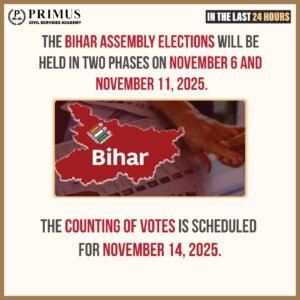
Relevance to UPSC
GS Paper II: Governance, Constitution & Polity
- Election Commission’s role in conducting free and fair elections.
- Implementation of Model Code of Conduct and its significance.
- Electoral reforms and their impact on the democratic process.
More about the News
- The Bihar Assembly Elections 2025 will be held in two phases: the first on November 6 (121 seats) and the second on November 11 (122 seats), with vote counting scheduled for November 14.
- Over 90,000 polling booths will be set up across the state for approximately 7.43 crore voters.
- The Model Code of Conduct has come into effect and the Election Commission has introduced several reforms, including 100% webcasting at all polling stations and the deployment of one General Observer per constituency.
Election Process in India
The election process in India, governed by the Constitution and relevant statutes, is fundamental to sustaining a vibrant democracy. It ensures transparency, efficiency, and integrity in conducting elections nationwide. This framework encompasses all stages, including scheduling, voting, counting, and declaration of results.
Constitutional Provisions on Elections
- Article 324 – Election Commission of India (ECI):
- Constitutional authority to supervise, direct, and control elections to Parliament, State Legislatures, President, and Vice-President.
- Ensures free and fair elections.
- Article 325 & 326 – Right to Vote and Universal Adult Suffrage:
- Article 325: No person shall be disqualified by religion, race, caste, or sex.
- Article 326: Direct elections by adult citizens for Lok Sabha and State Assemblies.
- Article 327 – Parliament to regulate elections:
- Empowers Parliament to make laws governing elections to Lok Sabha and State Legislative Assemblies.
- Empowers Parliament to make laws governing elections to Lok Sabha and State Legislative Assemblies.
- Article 329 – Bar on interference by courts:
- Courts cannot interfere with the conduct or results of ongoing elections to Parliament or State Legislatures.
- Courts cannot interfere with the conduct or results of ongoing elections to Parliament or State Legislatures.
- Articles 330 & 332 – Reservation of Seats:
- Seats in Lok Sabha and State Assemblies reserved for Scheduled Castes and Scheduled Tribes.
- Seats in Lok Sabha and State Assemblies reserved for Scheduled Castes and Scheduled Tribes.
- Articles 243K & 243ZA – Elections to Panchayats and Municipalities:
- Provides for direct elections, regular conduct, and superintendence by State Election Commission.
Election Process in India
- Refers to the series of steps through which elections are conducted and representatives are chosen by the people in a democratic system.
- Governed by constitutional provisions and election laws, ensuring a structured process and dedicated election machinery.
- Key stages of the election process:
- Announcement of Election Schedule by the Election Commission of India (ECI).
- Issue of Notification by the ECI.
- Filing of Nominations by candidates.
- Oath or Affirmation of candidates.
- Election Campaigns conducted by candidates.
- Polling of Votes by eligible voters.
- Counting of Votes after polling concludes.
- Constitution of the House based on the declared results.
Stages
- Announcement of Election Schedule by ECI:
- ECI initiates electoral machinery when a legislature’s term ends or is dissolved.
- Schedules announced via press conference weeks before elections, including dates for nominations, polling, and counting.
- Model Code of Conduct (MCC) comes into effect immediately after the announcement.
- Issue of Notification by ECI:
- Official notification calls upon voters to elect members of the House.
- Marks the formal start of the election process.
- Filing of Nominations:
- Candidates submit nominations within one week of notification.
- Returning Officers scrutinize papers; invalid nominations are rejected.
- Candidates may withdraw within two days post-scrutiny.
- Oath or Affirmation of Candidates:
- Candidates take an oath/affirmation before authorized officers (usually RO/ARO).
- Done immediately after filing nominations or before scrutiny of papers.
- Election Campaigns:
- Begins after nominations are finalized; concludes 48 hours before polling.
- Candidates and parties must adhere to the Model Code of Conduct.
- Election Manifestos outline party policies, promises, and critique opponents.
- Symbols allocated: reserved for recognized parties; others receive from free symbol list.
- Polling of Votes:
- Elections conducted in multiple phases to ensure security and smooth conduct.
- Voting procedure:
- Done via Electronic Voting Machines (EVMs).
- Secret ballot system maintained.
- Polling stations within 2 km of voters; max 1200 voters per station.
- Voter identity verified, indelible ink applied, vote cast via control unit.
- Supervision of Elections:
- ECI deploys observers to ensure fair campaigns.
- Election Expenditure Observers monitor the spending limits of candidates and parties.
- Media Coverage:
- Media allowed to cover polling and counting; maintain transparency.
- Special passes for polling stations and counting halls.
- Media can conduct opinion polls and exit polls.
- Counting of Votes:
- Conducted under the supervision of Returning Officers and ECI observers.
- The candidate with the highest votes is declared as winner.
- Constitution of the House:
- ECI issues notification of elected members.
- The President (for Lok Sabha) or the Governor (for State Assemblies) convenes the House.
- ECI issues notification of elected members.
- Electoral System:
- First-Past-the-Post (FPTP): Candidate with the maximum votes in a constituency wins.
- Applies to both Lok Sabha and State Legislative Assemblies
- Election Petitions:
- Filed by voters/candidates alleging malpractices.
- Tried by High Courts; can result in re-election in the affected constituency.
The election process in India is a robust mechanism that ensures free, fair, and transparent elections, reflecting the essence of democracy. It forms the backbone of the world’s largest democracy, upholding the people’s will and representative governance. As India evolves, the system must adapt to new challenges while preserving its foundational democratic principles.
Prelims MCQ
Q.
Consider the following statements (PYQ 2017):
1. The Election Commission of India is a five-member body.
2. The Union Ministry of Home Affairs decides the election schedule for the conduct of both general elections and bye-elections.
3. Election Commission resolves the disputes relating to splits/mergers of recognised political parties.
Which of the statements given above is/are correct?
A. 1 and 2 only
B. 2 only
C. 2 and 3 only
D. 3 only
Statement 1 is incorrect: ECI is a three-member body (Chief Election Commissioner + two Election Commissioners). Statement 2 is incorrect: The Election Commission of India, not the Ministry of Home Affairs, decides the election schedule. Statement 3 is correct: ECI resolves disputes related to splits and mergers of recognised political parties under the law.
Mains Question
Q. Discuss the role of the Election Commission of India in the light of the evolution of the Model Code of Conduct (MCC). (PYQ 2022)
India secures record-breaking medal haul at World Para Athletics Championships
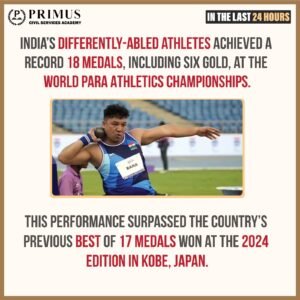
Relevance to UPSC
GS Paper II: Governance
- Promotion of inclusive sports and support for differently-abled athletes.
- Government policies and schemes aimed at enhancing opportunities for para-athletes.
- International cooperation and India’s role in hosting global sporting events.
More about the News
- India achieved its best-ever performance at the World Para Athletics Championships 2025 in New Delhi, securing 22 medals: 6 gold, 9 silver and 7 bronze, placing 10th overall among 104 participating nations.
- Notable achievements include Nishad Kumar setting a new Asian record in the men’s high jump T47 category with a jump of 2.14m and Simran Sharma winning gold in the women’s 100m T12 final with a personal best time of 11.95s.
- The event featured over 2,000 athletes, highlighting India’s growing prominence in para-athletics and the effectiveness of its investment in sports infrastructure and athlete development.
World Para Athletics Championships
The World Para Athletics Championships is a premier global competition for differently-abled athletes, showcasing their talent and resilience. It promotes inclusivity and competitive sports for persons with disabilities on an international stage. The event reflects the spirit of determination, excellence, and the global recognition of para-sports.
Background
- First held in 1994 as the IPC Athletics World Championships.
- Conducted biennially under the governance of World Para Athletics, a sub-division of the International Paralympic Committee (IPC).
- Designed to provide competitive opportunities for athletes with physical, visual, and intellectual impairments.
Objectives
- Promote sports participation among differently-abled persons.
- Identify and nurture talent for the Paralympic Games.
- Raise awareness about the capabilities of differently-abled athletes.
- Promote global standards and fairness in para-athletics.
Organisation and Members
- Governed by World Para Athletics under IPC.
- Participating nations send athletes based on qualification standards.
- Officials include technical delegates, classifiers, referees, and volunteers ensuring compliance with IPC rules.
Games / Categories Involved
- Track events: 100m, 200m, 400m, 800m, 1500m, relay races.
- Field events: Long jump, high jump, shot put, javelin throw, discus throw.
- Classification system: Categories like T (Track) and F (Field) with numerical codes based on type and severity of impairment.
Need for the Championship
- Provides competitive exposure to differently-abled athletes.
- Encourages inclusivity and social integration.
- Helps identify medal prospects for Paralympic Games.
Challenges Faced
- Lack of infrastructure and accessibility in some countries.
- Limited media coverage and sponsorship.
- Difficulties in classification and fair competition among diverse impairments.
- Social and cultural stigma toward differently-abled athletes.
Government Initiatives Taken
- Target Olympic Podium Scheme (TOPS): Financial support and training for para-athletes.
- Khelo India Para Games: National platform to nurture talent.
- Increased investment in accessible facilities, coaching, and international exposure.
Way Forward
- Enhance media coverage and sponsorship opportunities.
- Improve accessible training infrastructure nationwide.
- Strengthen grassroots programs to identify talent early.
- Foster international collaborations for coaching and technology.
- Promote awareness campaigns to reduce stigma and encourage participation.
The World Para Athletics Championships will continue to inspire differently-abled athletes globally and redefine excellence in sports. Strengthened support systems and inclusivity measures can help emerging talent achieve international success. Greater societal recognition and investment will make para-athletics a mainstream sporting pursuit worldwide.
Prelims MCQ
Q. Which of the following statements about the World Para Athletics Championships is/are correct?
1. It is conducted biennially under the International Paralympic Committee (IPC).
2. The classification system in para-athletics is based solely on age categories.
3. India participates and selects athletes through the Khelo India Para Games and TOPS.
A. 1 and 2 only
B. 2 and 3 only
C. 1 and 3 only
D. All of the above
Statement 1 is correct: The Championships are held biennially under IPC governance. Statement 2 is incorrect: Classification is based on type and severity of impairment, not age. Statement 3 is correct: India selects para-athletes through initiatives like Khelo India Para Games and TOPS.
.Mains Question
Q. Critically examine the role of the World Para Athletics Championships in promoting inclusivity and excellence in sports. Discuss the challenges faced by differently-abled athletes in India and suggest measures to enhance their participation and performance at global events.



